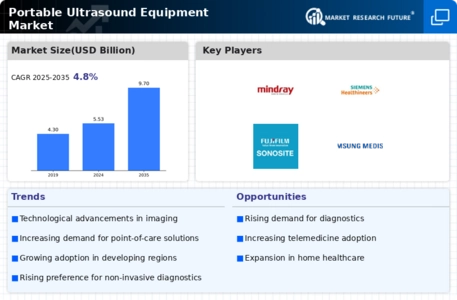Expansion of Telemedicine Services
The Portable Ultrasound Equipment Market is poised for growth due to the expansion of telemedicine services. As healthcare systems increasingly adopt telehealth solutions, the demand for portable ultrasound devices that can be integrated into remote consultations is rising. These devices facilitate real-time imaging and allow healthcare providers to conduct assessments without the need for in-person visits. The convenience and efficiency offered by portable ultrasound equipment align well with the goals of telemedicine, which aims to enhance access to care. As telehealth continues to evolve, the Portable Ultrasound Equipment Market is likely to experience significant growth, driven by the need for innovative diagnostic tools that support remote patient management.
Technological Innovations in Imaging
The Portable Ultrasound Equipment Market is experiencing a surge in technological innovations that enhance imaging quality and diagnostic capabilities. Advancements such as 3D and 4D imaging, along with improved resolution, are making portable ultrasound devices more effective in clinical settings. These innovations are not only improving patient outcomes but also increasing the adoption of portable devices in various healthcare facilities. The market is projected to grow at a compound annual growth rate of approximately 8% over the next few years, driven by these technological advancements. As healthcare providers seek to improve diagnostic accuracy and efficiency, the demand for high-quality portable ultrasound equipment is likely to rise, further propelling the market forward.
Rising Incidence of Cardiovascular Diseases
The Portable Ultrasound Equipment Market is significantly influenced by the rising incidence of cardiovascular diseases worldwide. As these conditions become more prevalent, the need for effective diagnostic tools is paramount. Portable ultrasound devices are increasingly utilized for cardiac assessments, enabling timely diagnosis and management of cardiovascular issues. According to recent statistics, cardiovascular diseases account for a substantial percentage of global mortality, highlighting the urgent need for accessible diagnostic solutions. The ability of portable ultrasound equipment to provide real-time imaging and facilitate immediate clinical decisions is likely to drive its adoption among healthcare providers, thereby contributing to market growth.
Growing Demand for Home Healthcare Solutions
The Portable Ultrasound Equipment Market is witnessing a notable increase in demand for home healthcare solutions. As the population ages and chronic diseases become more prevalent, there is a growing need for medical devices that can be used outside traditional clinical environments. Portable ultrasound equipment offers the flexibility and convenience required for home-based care, allowing healthcare professionals to conduct examinations in patients' homes. This trend is supported by the increasing emphasis on patient-centered care and the desire to reduce hospital visits. The market for portable ultrasound devices is expected to expand significantly as more healthcare providers adopt these technologies to meet the needs of patients in home settings.
Increased Focus on Maternal and Fetal Health
The Portable Ultrasound Equipment Market is benefiting from an increased focus on maternal and fetal health. Healthcare providers are increasingly recognizing the importance of regular monitoring during pregnancy, which has led to a rise in the use of portable ultrasound devices for prenatal care. These devices allow for convenient and safe assessments of fetal development, enabling early detection of potential complications. The market is projected to see a significant uptick in demand as more expectant mothers seek accessible and reliable prenatal monitoring options. This trend is further supported by initiatives aimed at improving maternal health outcomes, which are likely to bolster the adoption of portable ultrasound technology.


















Leave a Comment